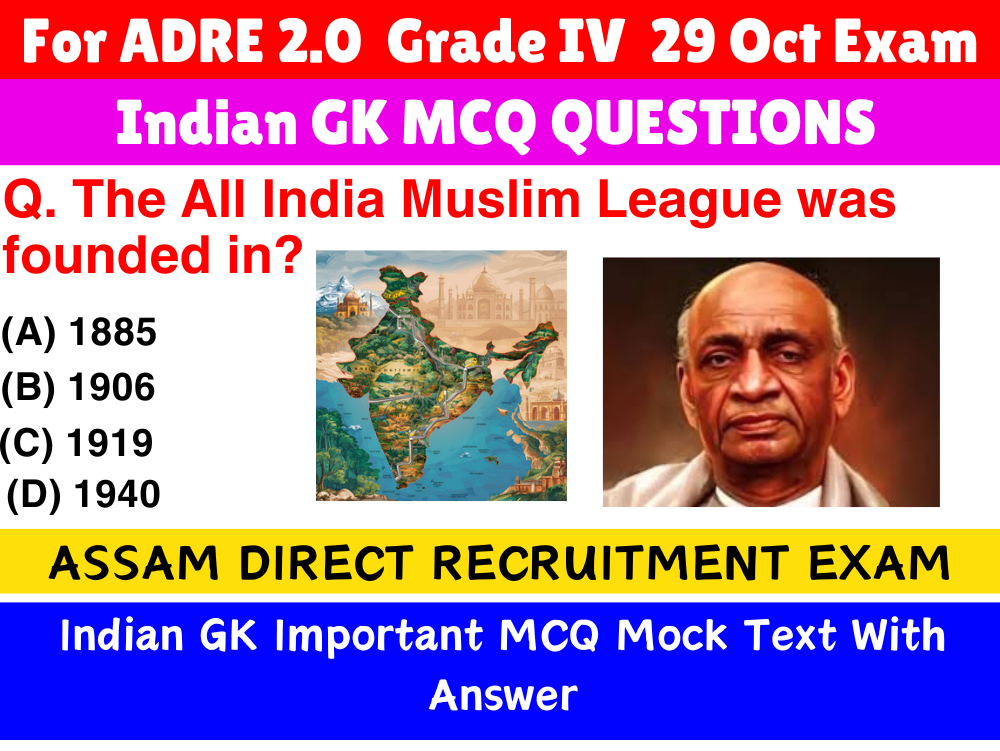Indian GK Important MCQ Mock Text With Answer – In this post we have shared।some of most important Indian GK for upcoming exam point of view. We created MCQs and share the information about latest and previous various Indian General Knowledge. These Questions are very much important for upcoming Adre 2.0, Assam Tet, Assam Police, SI, Apsc etc. Exams. All MCQs Shared here are on various topics like : Assam Govt Recent Initiative, Orunodoi Schemes, Sarothi Scheme, Budget etc.
1. Who was the founder of the Maurya Empire?
a) Ashoka
b) Bindusara
c) Chandragupta Maurya
d) Kautilya
Answer: c) Chandragupta Maurya
2. The Ajanta Caves are associated with which religion?
a) Hinduism
b) Jainism
c) Buddhism
d) Sikhism
Answer: c) Buddhism
3. Who among the following was known as the “Napoleon of India”?
a) Chandragupta I
b) Samudragupta
c) Ashoka
d) Harshavardhana
Answer: b) Samudragupta
4. Who wrote the famous book “Arthashastra”?
a) Kalidasa
b) Kautilya
c) Vishnugupta
d) Bhaskaracharya
Answer: b) Kautilya
5. Which ruler was known for issuing the Edicts of Ashoka?
a) Bimbisara
b) Ashoka
c) Kanishka
d) Harsha
Answer: b) Ashoka
6. Which of the following empires ruled during the Golden Age of India?
a) Mughal Empire
b) Gupta Empire
c) Maurya Empire
d) Chola Empire
Answer: b) Gupta Empire
7. Which battle marked the beginning of Mughal rule in India?
a) Battle of Plassey
b) Battle of Panipat
c) Battle of Haldighati
d) Battle of Talikota
Answer: b) Battle of Panipat (First Battle of Panipat, 1526)
8. Who was the first Indian woman to become the President of the Indian National Congress?
a) Sarojini Naidu
b) Indira Gandhi
c) Vijayalakshmi Pandit
d) Annie Besant
Answer: d) Annie Besant
9. Who founded the Indian National Congress (INC) in 1885?
a) Mahatma Gandhi
b) A.O. Hume
c) Bal Gangadhar Tilak
d) Subhas Chandra Bose
Answer: b) A.O. Hume
10. The Non-Cooperation Movement was launched in which year?
a) 1915
b) 1919
c) 1920
d) 1922
Answer: c) 1920
11. Which of the following dynasties built the famous rock-cut temples of Mahabalipuram?
a) Cholab) Pallavac) Pandyad) Chera
Answer: b) Pallava
12. Who was the first Governor-General of independent India?
a) Lord Mountbatten
b) C. Rajagopalachari
c) Dr. Rajendra Prasad
d) Jawaharlal Nehru
Answer: a) Lord Mountbatten
13. The capital of the Vijayanagara Empire was located at?
a) Mysore
b) Hampi
c) Madurai
d) Kanchi
Answer: b) Hampi
14. Which Mughal emperor was also known as “Zinda Pir” (Living Saint)?
a) Babur
b) Akbar
c) Aurangzeb
d) Shah Jahan
Answer: c) Aurangzeb
15. The ‘Quit India Movement’ was launched in which year?
a) 1939
b) 1940
c) 1942
d) 1944
Answer: c) 1942
16. The Jallianwala Bagh massacre took place in which city?
a) Delhi
b) Amritsar
c) Lahore
d) Kanpur
Answer: b) Amritsar
17. Who was the first Indian ruler to accept the Subsidiary Alliance of the British?
a) Tipu Sultan
b) Nizam of Hyderabad
c) Maharaja Ranjit Singh
d) Peshwa Baji Rao II
Answer: b) Nizam of Hyderabad
18. Which of the following was a major cause of the Revolt of 1857?
a) Abolition of Sati
b) Introduction of the Enfield rifle
c) Spread of Western education
d) Introduction of railways
Answer: b) Introduction of the Enfield rifle
19. Who was the first Indian to win a Nobel Prize?
a) C.V. Raman
b) Rabindranath Tagore
c) Hargobind Khorana
d) Mother Teresa
Answer: b) Rabindranath Tagore
20. Which of the following kingdoms was founded by Maharana Pratap?
a) Mewar
b) Marwar
c) Bundelkhand
d) Gwalior
Answer: a) Mewar
21. The Simon Commission, which faced widespread protests, arrived in India in?
a) 1920
b) 1925
c) 1928
d) 1930
Answer: c) 1928
22. The famous Battle of Plassey was fought in which year?
a) 1747
b) 1757
c) 1764
d) 1775
Answer: b) 1757
23. Who introduced the Doctrine of Lapse?
a) Lord Dalhousie
b) Lord Wellesley
c) Lord Curzon
d) Lord Hastings
Answer: a) Lord Dalhousie
24. Which of the following was the first Indian movement to demand complete independence?
a) Non-Cooperation Movement
b) Swadeshi Movement
c) Home Rule Movement
d) Purna Swaraj Resolution
Answer: d) Purna Swaraj Resolution (1930)
25. Who was the first Indian Governor-General of India?
a) Jawaharlal Nehru
b) Rajendra Prasad
c) C. Rajagopalachari
d) B.R. Ambedkar
Answer: c) C. Rajagopalachari
26. Which empire did Sher Shah Suri defeat to establish the Sur Empire?
a) Mughals
b) Marathas
c) Rajputs
d) Lodis
Answer: a) Mughals
27. Who was the founder of the Brahmo Samaj?
a) Swami Vivekananda
b) Dayanand Saraswati
c) Raja Ram Mohan Roy
d) Ishwar Chandra Vidyasagar
Answer: c) Raja Ram Mohan Roy
28. Who led the revolt of 1857 in Kanpur?
a) Nana Saheb
b) Tantia Tope
c) Rani Lakshmibai
d) Bahadur Shah Zafar
Answer: a) Nana Saheb
29. Which Indian leader is known as the “Iron Man of India”?
a) Jawaharlal Nehru
b) Sardar Vallabhbhai Patel
c) Subhas Chandra Bose
d) Bal Gangadhar Tilak
Answer: b) Sardar Vallabhbhai Patel
30. The Battle of Buxar was fought between the British and?
a) Tipu Sultan
b) Marathas
c) Mughals
d) The Nawab of Bengal
Answer: d) The Nawab of Bengal (Mir Qasim), along with the Mughal Emperor and the Nawab of Awadh
31. The First Round Table Conference was held in which year?
a) 1927
b) 1930
c) 1931
d) 1932
Answer: b) 1930
32. Who was the main architect of the Indian Constitution?
a) Mahatma Gandhi
b) B.R. Ambedkar
c) Jawaharlal Nehru
d) Sardar Patel
Answer: b) B.R. Ambedkar
33. Who was the Viceroy of India during the partition of Bengal in 1905?
a) Lord Curzon
b) Lord Canning
c) Lord Ripon
d) Lord Lytton
Answer: a) Lord Curzon
34. The All India Muslim League was founded in?
a) 1885
b) 1906
c) 1919
d) 1940
Answer: b) 1906
35. Who was the first President of independent India?
a) Jawaharlal Nehru
b) Mahatma Gandhi
c) Rajendra Prasad
d) Sardar Patel
Answer: c) Rajendra Prasad
36. The Champaran Satyagraha was related to?
a) Cotton cultivation
b) Indigo cultivation
c) Salt production
d) Textile industry
Answer: b) Indigo cultivation
37. The famous Indian leader Subhas Chandra Bose formed which government in exile during World War II?
a) Indian National Congress
b) Provisional Government of Free India (Azad Hind)
c) Swaraj Party
d) Khilafat Movement
Answer: b) Provisional Government of Free India (Azad Hind)
38. Which British Governor-General introduced English education in India?
a) Lord Curzon
b) Lord Wellesley
c) Lord William Bentinck
d) Lord Dalhousie
Answer: c) Lord William Bentinck
39. The Rowlatt Act was passed in?
a) 1916
b) 1918
c) 1919
d) 1921
Answer: c) 1919
40. The leader of the Bardoli Satyagraha (1928) was?
a) Mahatma Gandhi
b) Sardar Vallabhbhai Patel
c) Bal Gangadhar Tilak
d) Jawaharlal Nehru
Answer: b) Sardar Vallabhbhai Patel
Read Also: Assam Weekly Current Affairs 23 to 29th September 2024

